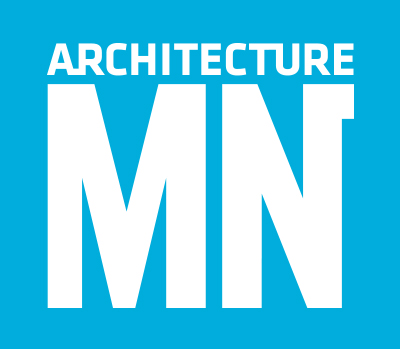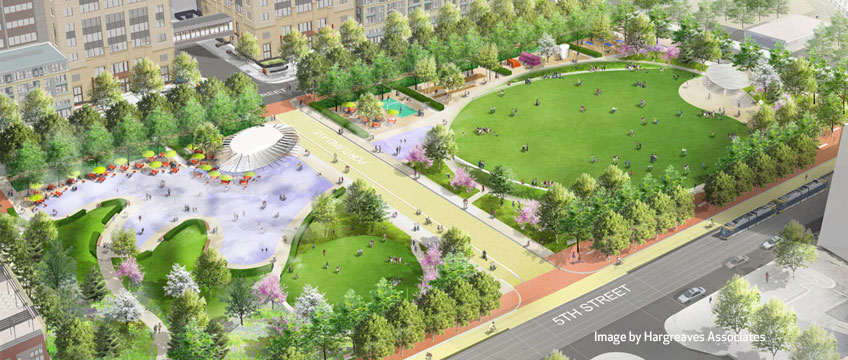The planning of the Commons, a two-block park in downtown Minneapolis, has captured the attention of the Twin Cities. What level of input should the public expect to have? And at what stage of the project would public input have the most impact?
By Frank Edgerton Martin
The City of Minneapolis invited the public to take part in the design process for the Commons, a planned 4.2-acre park at the heart of the fast-redeveloping area between the downtown core and the new Vikings stadium. One of the largest urban landscape projects in the country, the two-block Commons will shape the downtown experience for thousands of residents and visitors on a weekly basis, so public input was essential. But should users drive the design? Or might their input be more valuable at an earlier stage?
In April, the Commons’ design team of Hargreaves Associates, Damon Farber Associates, and VJAA held a forum at the Mill City Museum to gather ideas on this linear urban space. Hargreaves senior principal Mary Margaret Jones took the 220 attendees through plans and diagrams that explained the subtle grade changes and the wind and solar patterns in this future outdoor room. Then she briefly introduced four design concepts—each with a different arrangement of possible program elements—to spur discussion. The program pieces included, in order of scale: a Great Lawn for game-related events, a Promenade stretching the length of the park, ponds or re-created wetlands, a café to be designed by VJAA, a terraced berm for seating, garden areas, playgrounds, and water features.
The four approaches expressed a gradient of large spaces nearest the stadium to more intimate paths and earthworks on the block to the northwest, across Portland Avenue. They ranged from a highly unified vision for the two blocks to one that specifies different scales and forms for each. Overall, we got a more detailed picture of the daily life of the park: large crowds on game days; food trucks doing business along Fourth Street South, across from the two Wells Fargo towers, on weekdays; children in the play areas after school. Portland Avenue’s sidewalks will be widened all the way to Washington for a river connection, and the street itself will be redesigned for only two traffic lanes plus bike lanes.
Like Hargreaves’ Olympic Park in London and 12-acre Discovery Green in Houston, the Commons will need to host big events yet also work when just a few people are around. In presenting all this, Jones was remarkably engaging and clear. The instant she concluded, a city employee sat down at my round table (one of a dozen) to facilitate discussion of the pros and cons of each approach.
We went around the circle and each said our piece, often agreeing but sometimes contradicting one another about where the different elements should go. Many college students participated, which I found encouraging. The city facilitator scribbled away as we rapidly made our way through the four schemes, and then a representative from each table stood up to summarize his or her group’s dialogue. Soon after, the hour-and-a-half-long meeting adjourned.
Some strong patterns of agreement emerged among the roughly 120 participants in the table discussions. There was general consensus, for example, that water features such as wetlands, ponds, and custom fountains are tough to maintain in our climate. There was strong support for the Great Lawn, likely to be located on the stadium-adjacent block, and for placing the intimate paths and play areas on the other block, in front of the Armory.
Several downtown residents commented that they felt more involved in the Commons planning process than in those for the Nicollet Mall renovation and Water Works Park. That’s not surprising, because the Nicollet Mall and Water Works teams won their commissions through design competitions that produced their “big idea” concepts. The Hargreaves team, selected through a proposal process, spent early 2015 developing basic programming through meetings and an online survey that generated 2,500 responses.
Facilitating public participation is no easy task for planners and designers. A design team needs public input on what uses will work and garner support for the project. It also needs to hear what might not work—like custom fountains in our climate. As of this writing, the Commons program remains in flux. Most people want it to be a destination focused on recreation and play, but the process is still defining what “play” really means. The challenge for the Hargreaves team is to build both consensus and public acceptance that not everyone can be fully satisfied.
The conundrum that arises is whether we expect too much from public participation in design. Some observers go so far as to argue that citizens, public artists, and neighborhoods should be able to shape and customize everything from bus stops to streetscapes and public art. Direct design democracy, you might call it. But there is a difference between creating a simple pop-up park, such as the piazza with Ping-Pong and bocce at Westminster Church on Nicollet Mall—a fun but temporary solution for a private space slated for redevelopment—and designing a major civic space like the Commons, which we hope will last for generations.
For lasting urban design, we, the citizens, should help set the program, and then step back to let the selected designers do their work. We should also come to grips with the fact that, in a time when more and more “public” spaces are being built in collaboration with private interests, major donors and investors will have a powerful voice in what gets built. Yet citizens must ask early on whether big projects are worth pursuing in the first place, who should be able to use them, and how much private-sector interests should control the process. (The Commons’ complex web of public land ownership and private management presents a related, equally weighty conundrum.)
Residents and business owners need to be more involved at the predesign stage, when the most important decisions are made. Projects like the Commons have been built for centuries as expressions of economic power, civic pride, and real estate opportunities, and they will be for centuries to come. We have the greatest chance to shape them if we ask bigger questions at the outset and not when design happens, at the end.



